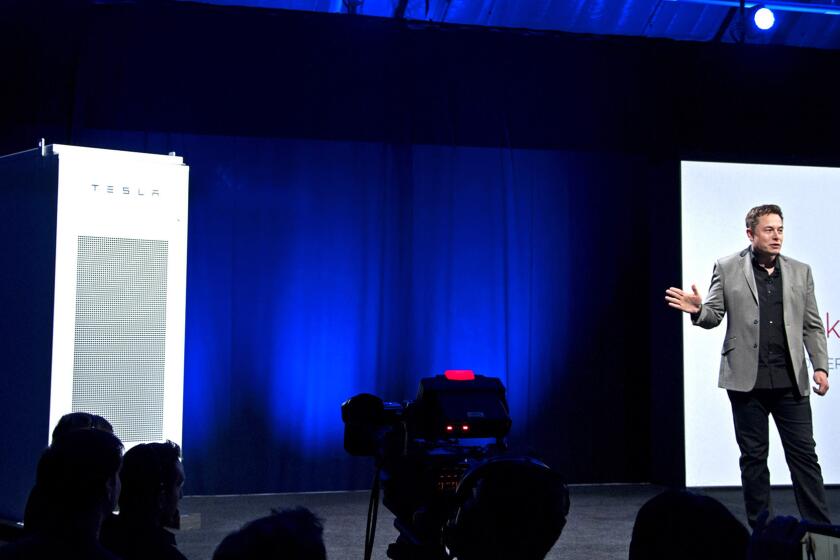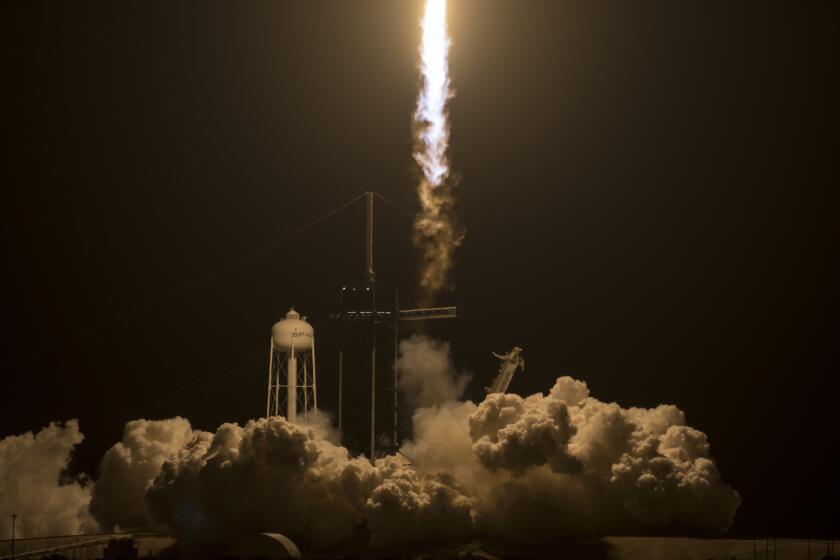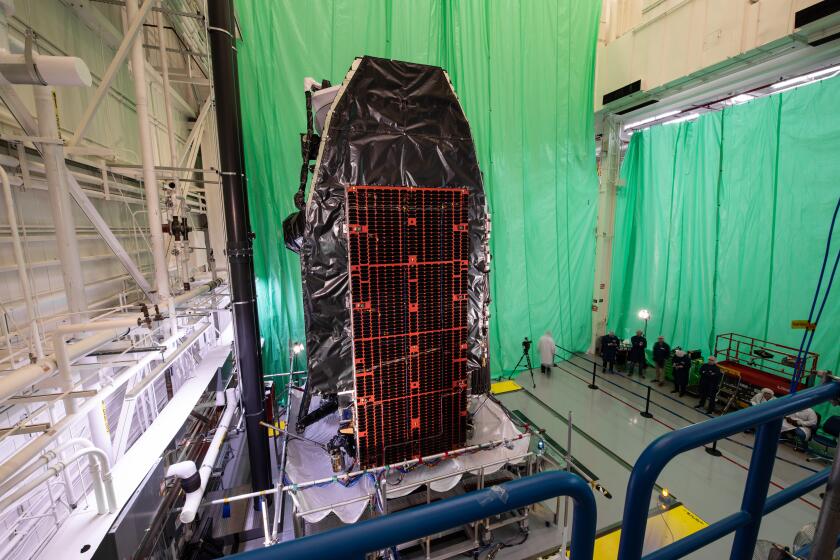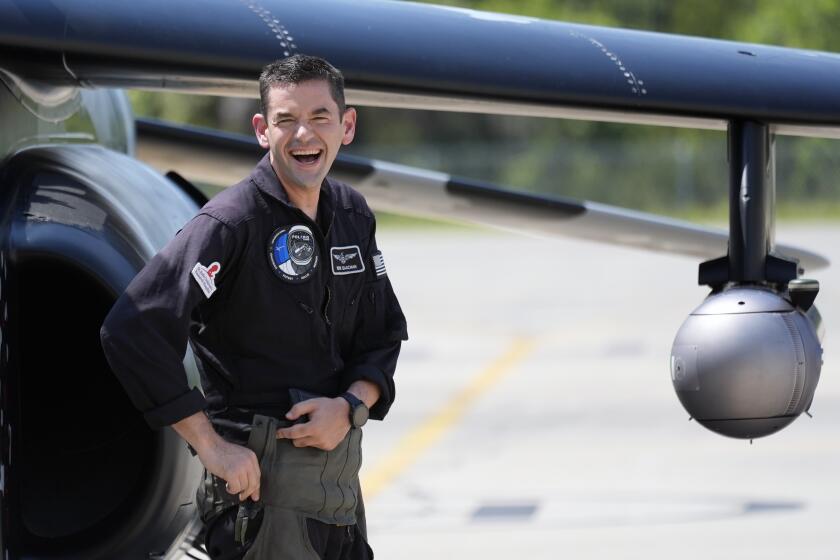Elon Musk revived L.A. aerospace with SpaceX. Will it thrive without him?
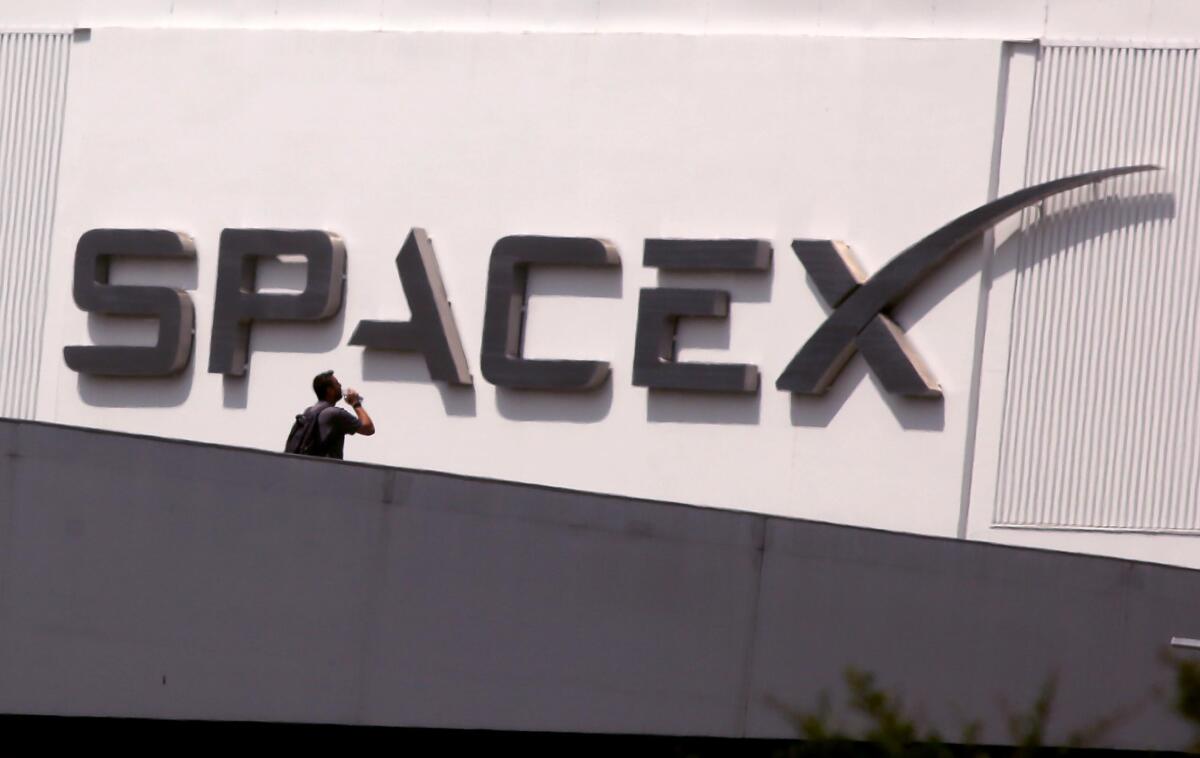
- Share via
When Elon Musk decided to start a rocket company two decades ago, he headed down Interstate 5 and the 405 and didn’t stop until he reached the South Bay, the center of the region’s aerospace industry, hard hit by a drop in defense spending after the Cold War.
There, the Silicon Valley entrepreneur, flush with cash from the sale of PayPal, founded Space Exploration Technologies in 2002 and defied skeptics, building his startup into a $210-billion giant and fueling a revitalization of the shrunken industry.
This week, the Hawthorne company’s future in the region was thrown into doubt when Musk posted on X that he planned to move SpaceX’s headquarters to the outskirts of Brownsville, Texas, where it is developing its massive Starship rocket for planned trips to the moon and, someday, Mars.
It’s unclear what the fallout will be locally.
SpaceX hasn’t commented on how many jobs will be affected by the relocation, and industry observers say it’s likely the company will maintain significant manufacturing operations in Los Angeles County, where it employed about 6,000 people in 2023, according to an annual survey by the Los Angeles Business Journal.
But the relocation is undoubtedly a loss to the region’s revived space industry.
A leader in the space economy
“SpaceX has been one of the pillars of the Southern California new space economy,” said Kevin Klowden, the Milken Institute’s executive director of MI Finance. The move “is significant symbolically in that it shows Southern California isn’t indispensable in an industry where it clearly is a leader.”
The aerospace industry was pioneered in L.A. County, with the first rockets set off in the Arroyo Seco near Caltech in the 1930s — the humble origins of what was to become the Jet Propulsion Laboratory, a leader first in rocket and satellite development and later in interplanetary spacecraft.
Douglas Aircraft, Lockheed, Northrop and other companies built hundreds of thousands of planes during World War II and maintained defense work here. In Downey, North American Aviation built the command module of the Apollo 11 spacecraft that landed astronauts on the moon. Rockwell International built the space shuttles in Downey and Palmdale.
Los Angeles entrepreneur Elon Musk has built a multibillion-dollar fortune running companies that make electric cars, sell solar panels and launch rockets into space.
The massive defense spending cuts after the collapse of the Soviet Union devastated the industry, dropping employment in the county from about 130,000 in 1990 to less than half that a decade later — but with its heritage, talent pool and world-class universities, the region was a logical place for SpaceX to set up shop.
A new, smaller, Southern California aerospace economy has since developed, building on the remaining operations of legacy companies and technological advancements — even as other centers have emerged, such as Kent, Wash., where Jeff Bezos’ Blue Origin space company is located.
Virgin Galactic, the space tourism company founded by British billionaire Richard Branson in 2004, is based in Tustin and has its design and manufacturing operations in Mojave, where it also performs test flights. Its commercial operations are in New Mexico.
Rocket Lab, a maker of lightweight rockets that launch small satellites, moved its headquarters to Long Beach just three years ago.
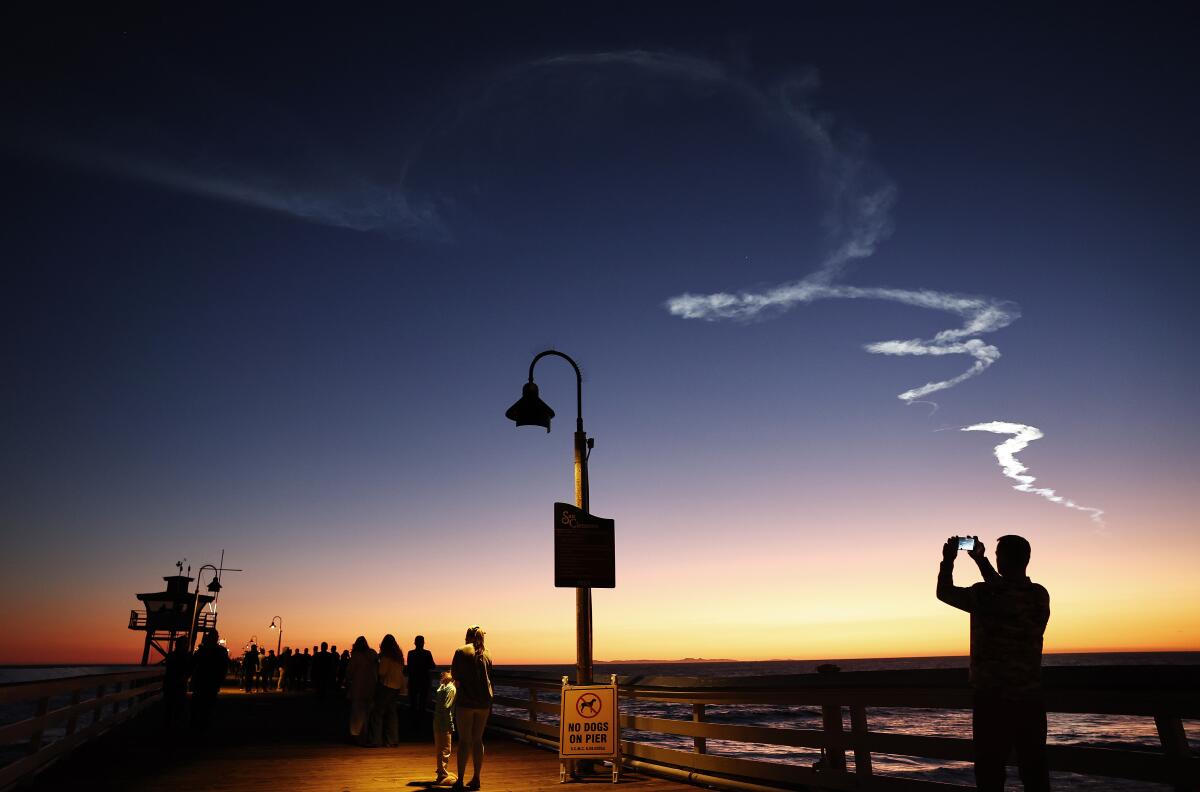
And former SpaceX employees have founded dozens of startups. Crunchbase, which tracks venture capital and startups, tallies more than 50. Local ones include Relativity Space, a Long Beach maker of reusable rockets; Varda Space Industries, an El Segundo company developing drugs in low-Earth orbit; and L.A. telemetry startup Sift, which raised $7.5 million in venture funding last year.
“SpaceX isn’t unique, but it’s the star,” said Klowden, noting the “ecosystem” that has sprung up around it.”
While Musk’s declaration Tuesday was prompted by a public policy dispute — Gov. Gavin Newsom’s decision to sign a bill prohibiting school districts from mandating that teachers notify parents about a student’s change in gender identity — Musk has long complained about the state’s regulatory environment and has a history of tangling with government officials.
He moved Tesla’s headquarters from Palo Alto to Austin, Texas, in 2021 after Alameda County ordered the company in 2020 to halt production amid the COVID pandemic. Separately, the billionaire noted crime concerns in also tweeting Tuesday that he plans to move X, the social media platform formerly known as Twitter, from San Francisco to Austin.
Klowden said he believed Musk has been considering the idea of moving SpaceX, though it’s still unclear exactly whether Musk plans to transfer a handful of executives, additional employees or all of the operations, which is not seen as likely. Neither Musk nor SpaceX has offered clarification. The company did not respond to requests for comment.
City officials were also grappling with the announcement.
“We understand that business decisions are driven by a variety of factors, and we remain committed to fostering a thriving business environment in Hawthorne,” Alex Vargas, the city’s mayor, said in a statement. He added: “[W]e want to reassure our workforce and community that the city of Hawthorne is taking proactive steps to mitigate the impact of SpaceX’s potential relocation.”
Much of the skepticism regarding Musk’s SpaceX tweet revolves around how the Tesla move was carried out. The electric vehicle maker produces its Model Y SUV and new Cybertruck in Austin but still operates a factory in Fremont, where it makes multiple models. Last year, Tesla said it was opening a new global engineering headquarters in Palo Alto previously occupied by the headquarters of Hewlett-Packard.
A flight to Texas?
But some familiar with the company think the headquarters relocation announcement could presage a larger presence in Texas.
Tim Buzza, a former SpaceX vice president, said that while the company builds its workhorse Falcon 9 rocket and Dragon capsules that service the International Space Station in Hawthorne, the company’s future is the massive Starship rocket being developed at the Brownsville facility called Starbase on the Gulf of Mexico.
“The center for the next level of execution for SpaceX is Starbase. The direction and the momentum of the company is already moving to Texas,” said Buzza, who was one of the first five employees at SpaceX, worked there for 12 years and remains in contact with many at the company.
SpaceX is seeking approval to launch 90 rockets from Vandenberg Space Force Base by 2026, a sharp increase from its previous plans for the Santa Barbara County military base. Buzza said the launches are important for the Starlink satellite broadband network SpaceX is building, since they put the satellites into a polar orbit, complementing Florida launches that put them in an equatorial orbit.
However, the Starship rocket — taller and more powerful than the Saturn 5 that launched Apollo astronauts to the moon — could launch many more satellites than the Falcon 9. SpaceX has opened a new Starlink factory outside Austin, and last month Starship completed its fourth test flight from Starbase, dubbed its “Gateway to Mars.”
The company has been building its operations at Starbase and this month asked the Federal Aviation Administration for permission for up to 25 annual launches of Starship and its Super Heavy rocket, a more powerful derivative of its Falcon 9. The company operates an engine testing facility in McGregor, Texas.
Klowden questioned the company’s ability to move or attract large numbers of workers to the Brownsville area, at least in the immediate future, given the lack of housing and other infrastructure. But Buzza said SpaceX overcame many of the same issues in McGregor. He doesn’t think Musk would move Falcon 9 production or the Dragon capsule program from Hawthorne, because both may be phased out over time.
SpaceX’s workhorse Falcon 9 that services the International Space Station failed Thursday night on a routine mission to place Starlink internet satellites into orbit.
Still, even the loss of SpaceX’s executive operations to Texas would be a blow to Los Angeles and the Golden State, which have suffered a humiliating series of corporate defections over the last few decades. L.A.-area companies that have moved headquarters elsewhere include Lockheed, Northrop Grumman and more recently Aecom, a global engineering firm. Software giant Oracle left Redwood City in Silicon Valley for Austin in 2020 (and has since announced a move to Nashville).
“Whenever any company announces that they might or they will leave the region, it is not good for us. We definitely need to do a much better job in terms of business retention,” said Stephen Cheung, chief executive of the Los Angeles County Economic Development Corp.
However, he said the region’s aerospace economy is still robust and has shown an ability to evolve. After the bankruptcy last year of Branson’s separate Virgin Orbit rocket company, Rocket Lab acquired the defunct company’s former Long Beach headquarters, he noted.
That move mirrors SpaceX’s evolution. Its first location in L.A. County was in El Segundo, but as it grew it moved in 2007 into an old Northrop site in Hawthorne that had been converted into a factory for the production of Boeing 747 fuselages.
Aerospace Corp., an El Segundo federally funded nonprofit that provides scientific and technical support to the aerospace industry, announced in March that it was moving its executive offices to Virginia but simultaneously announced it was investing $100 million in its local campus.
The region is still home too for major defense work.
Northrop Grumman is building the new B-21 digital bomber in Palmdale, which is slated to replace the B-2 stealth bomber it built decades ago in Pico Rivera. The high desert city also is home to Lockheed Martin’s famed “Skunk Works,” a secretive, cutting-edge military research and development facility.
Klowden said that for some SpaceX workers a move to South Texas could be a no-go, and he expects other aerospace companies will attempt poach its workers. Indeed, Orange County asteroid mining company Astroforge Inc. said it was hiring in a reply to Musk’s SpaceX tweet.
Earlier this week, workers streaming in and out of SpaceX’s Hawthorne complex declined to speak to a Times reporter. However, a salesman for SpaceX vendor GF Machining Solutions who asked his name not be used, said he hopes Musk was not serious about relocating the headquarters to Texas.
“Well, I wouldn’t want that to happen, because I’ve lived in California all my life and I would lose that account if SpaceX moved,” the Corona resident said. “I’m not moving to Texas.”
Times staff writer Ashley Ahn and Bloomberg News contributed to this report.
More to Read
Inside the business of entertainment
The Wide Shot brings you news, analysis and insights on everything from streaming wars to production — and what it all means for the future.
You may occasionally receive promotional content from the Los Angeles Times.
